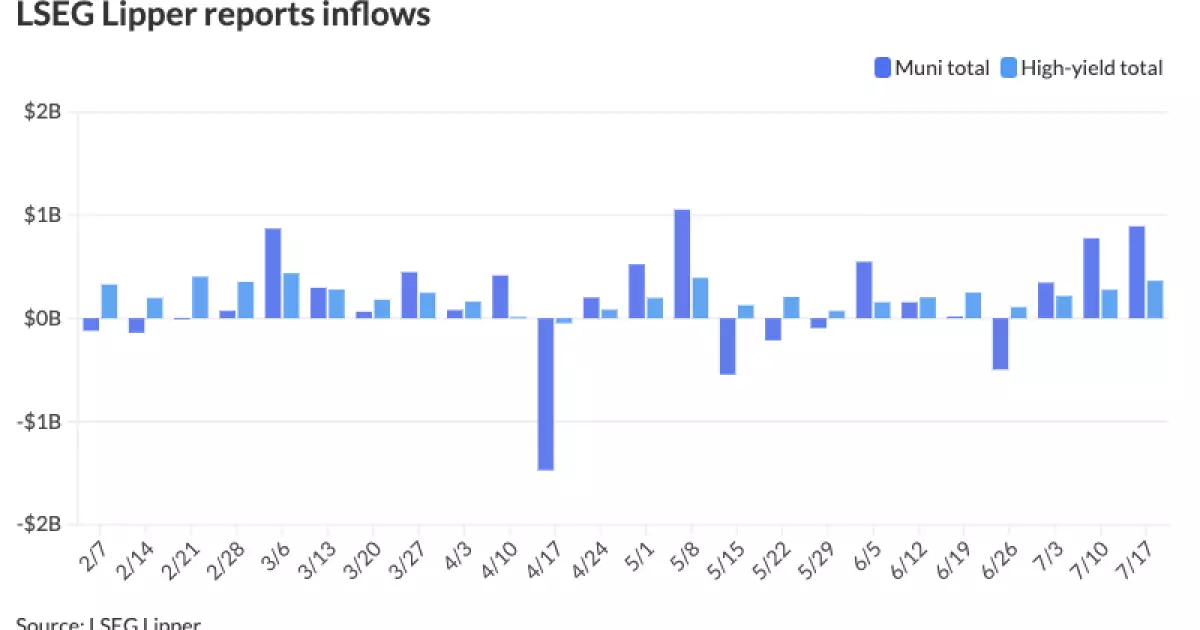In recent developments within the municipal bond market, a notable shift has occurred as short-term municipalities demonstrated an uptick in stability. The observed resilience is underpinned by consistent inflows into muni mutual funds and a deceleration in primary market activities. However, this optimism contrasts with a backdrop of rising U.S. Treasury yields and a downturn in equity markets. Despite the complex interplay of these financial instruments, municipal bonds have garnered attention, particularly due to favorable ratios against Treasury yields that suggest a healthy risk-reward profile.
According to data from Refinitiv, the relationship between municipal bonds and U.S. Treasuries remains compelling. The two-year muni-to-Treasury ratio stands at 64%, with extended tenors presenting similar attractiveness at 67% for the ten-year and increasing to 83% for the thirty-year. Such metrics suggest that while equities face volatility, municipal bonds present an appealing alternative for conservative investors seeking stability and reasonable yields.
Investor Inflows and High-Yield Strength
The burgeoning enthusiasm surrounding municipal bonds is corroborated by a significant influx of investor capital. In the latest reports from LSEG Lipper, municipal bond mutual funds attracted nearly $891.4 million, marking an increase from prior week inflows. Within this category, high-yield municipals are particularly thriving, capturing $364.4 million, reflecting a robust appetite for yield in a still low-interest-rate environment. This trend illustrates not just a defensive positioning by investors but also a strategic move to seek higher returns amid persistent economic uncertainties.
Market analysts from GW&K Investment Management have noted substantial improvement in the outlook for municipal bonds, particularly in the wake of strengthening credit fundamentals and prudent fiscal strategies by municipal issuers. The second quarter’s end yielded absolute yields at the upper range of historical averages while the relative value ratios have relaxed from previous extremes. Such factors collectively contribute to a more favorable environment for both risk-averse and yield-seeking investors.
As summer approaches its peak, historical performance suggests that July is traditionally favorable for municipal bonds. Analysts from BlackRock highlight that this month has consistently delivered positive returns, benefiting from increased reinvestment flows juxtaposed with lower issuance levels. Retail investors are particularly bolstered by the attractive yield environment, suggesting a cyclical pattern that emotions and quantitative data can be leveraged.
Despite some performance being drawn forward into June, various factors promise continued strength for municipal bonds. Generally supportive interest rates through the summer months together with the seasonal influx of cash, certainly positions this asset class favorably. Moreover, the medium-term outlook remains positive, sustained by heightened demand aligned with the typical issuance schedules and fiscal cycles of municipalities.
The duality of demand and supply remains a critical feature within the municipal bond landscape. Current events reveal a slow in issuance after a weeks of activity, exemplified by notable offerings from the San Francisco Public Utilities Commission and the Metropolitan Transportation Authority. These transactions highlight the intricate dynamics of high-quality issuance while market indices exhibit flatness, confirming that robust issuance can coexist with stagnant market growth.
Craig Brandon from Morgan Stanley emphasizes that, despite the high volume of issuance, it is not an unfavorable sign for the market. A perceived supply-demand mismatch in the high-yield segment indicates that there are opportunities for savvy investors. As various large-scale transactions come online, analysts anticipate enhanced market participation, potentially stabilizing trading conditions as summer progresses.
Nevertheless, caution persists amidst the infrastructure of confidence in the municipal bond market. Analysts at GW&K have raised flags regarding the flattening of the yield curve, which curtails the additional yield available to investors and may impact overall market dynamism. Alongside this risk, the potential for volatility surrounding the upcoming November elections could serve as a catalyst for market recalibrations based on shifting investor sentiment.
Interestingly, money market funds have not reflected the same inflows as municipal bonds, with recent data indicating a slight outflow. As market participants calibrate their risk profiles, there’s a growing expectation that a pivot toward longer-duration risk assets will emerge. Observing interest rate trends from the Federal Reserve will be crucial as market participants reevaluate their asset allocations in anticipation of shifting monetary policies.
While the municipal bond market is navigating a myriad of factors affecting yields and inflows, the ongoing trends suggest a compelling case for both conservative and high-yield investors. It is imperative for market participants to remain vigilant and adaptable to the rapidly changing economic environment, leveraging both quantitative and qualitative insights to inform their investment strategies.


Leave a Reply